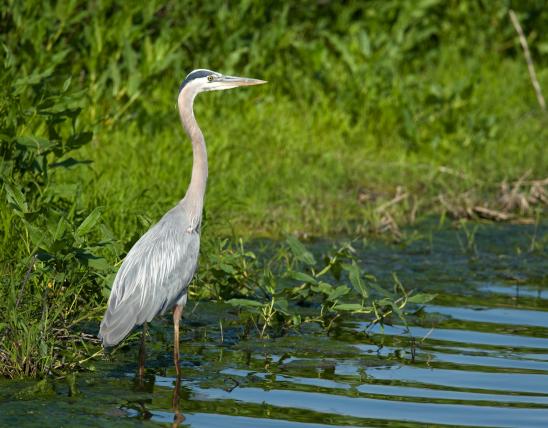
Yellow-crowned night-heron adults are gray with dark markings on back and wings; head black, with creamy white cheek patch and crown. Eyes red. Whitish head plumes develop in breeding season. Immatures dark brown with white streaks and spots on the feathers; they are less streaked and spotted than immature black-crowned night-herons; the bill is all dark and heavier than that of the black-crowned. Legs are longer than the black-crowned’s, with the feet plus the lower legs extending well beyond the tail in flight. Voice is a short quoc, higher but otherwise somewhat resembling the black-crowned’s call.
Similar species: Adult black-crowned night-herons have an all-black crown and back. Immatures of that species are more streaked and spotted, have slimmer bills with a light-colored base, and have shorter legs (in flight, only the feet can be seen beyond the tail). American bitterns in flight have slimmer, pointier wings whose upper surfaces have a chocolate brown outer half and lighter brown inner half. In night-herons, the upper wings look solid dark brown.
Length: 24 inches (tip of bill to tip of tail).

Statewide. In summer, especially May through August, most likely to be seen in southeast Missouri.
Habitat and Conservation
Rare summer resident, usually nesting in pairs near streams, marshes, and wooded wetlands. At night they forage in shallow water, such as riffles of Ozark streams, and may occasionally be seen at dawn or dusk before they retreat into nearby vegetation. May nest in loose colonies.
Food
This species forages at night for crayfish in shallow water, such as riffles of Ozark streams. Although active in the daytime and not strictly nocturnal, night-herons get their name from their habit of foraging primarily in the evening. Other prey include worms, fish, leeches, insects, and other small animals they can capture and swallow. Along coasts, they have a greater variety of crustaceans to eat.
Status
Uncommon transient and uncommon postbreeding wanderer statewide. As summer resident, uncommon and local in southeast Missouri, and rare elsewhere. Populations seem secure, though destruction of wetland habitats poses a real threat. Before conservation laws were enacted, these birds were hunted for meat and for their beautiful, graceful plumes.
Life Cycle
This species ranges from the coasts of Brazil, Central America, and the Caribbean year-round, but for summer breeding expands its range north into Kansas, Missouri, Illinois, and Indiana, and along the East Coast into New England. They nest in small colonies. Both parents work to construct the nest of sticks in a tree limb overhanging water. A clutch comprises 2–6 eggs. Hatchlings are down-covered, helpless, and stay at the nest for about a month. The same nest is often used year after year.
Human Connections
T. Gilbert Pearson, a famous ornithologist, once ventured deep into a Florida pond “infested with water-moccasins and alligators.” Chest-deep in “scum-water” and 60 yards from shore, he was “startled beyond all description” by a “sudden hoarse cry and heavy flapping” overhead. It was a colony of yellow-crowned night-herons!
Ecosystem Connections
Wetland birds interconnect aquatic ecosystems with those of land. Eating, they take nutrients from water in the form of crayfish. Later, they may deposit those nutrients back on land in the form of guano or their own spent bodies, whether they have been eaten as prey or not.










About 350 species of birds are likely to be seen in Missouri, though nearly 400 have been recorded within our borders. Most people know a bird when they see one — it has feathers, wings, and a bill. Birds are warm-blooded, and most species can fly. Many migrate hundreds or thousands of miles. Birds lay hard-shelled eggs (often in a nest), and the parents care for the young. Many communicate with songs and calls.





























